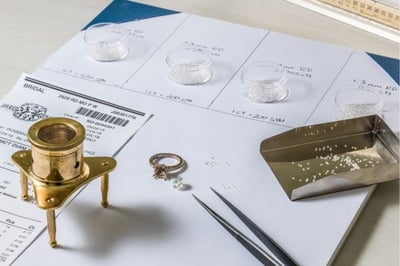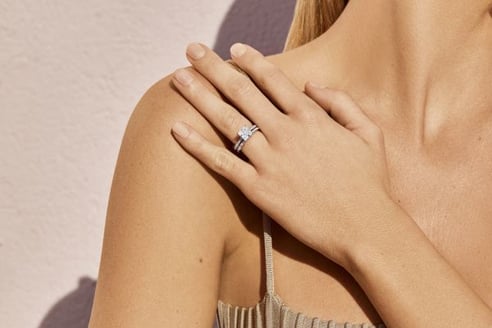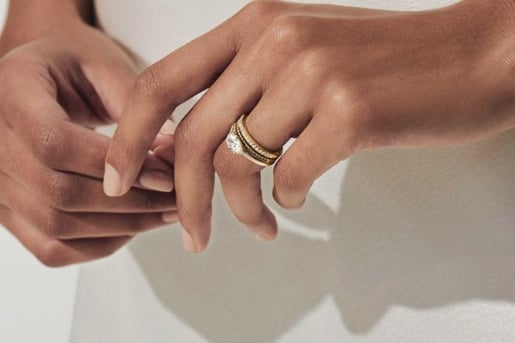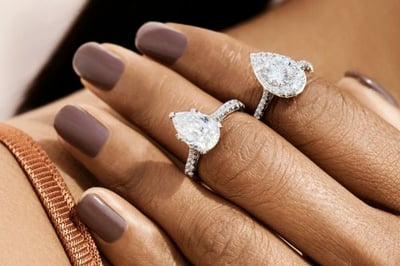How To Buy a Diamond: Do You Know the 4 Cs?
October 3, 2023 •Team Tacori

How do you choose a diamond for your engagement ring?
As the focal point of any engagement ring, your diamond will be a part of your partnership for many years to come. And just like love, no two of these precious gemstones are identical. Each has its own unique characteristics that will be an integral part of your love story. But with such a dazzling array of diamond ,it can be hard to know where to start with this deeply personal purchase.
In your diamond search, you’ll hear many new terms, whether that’s the 4 Cs of diamonds, diamond color and clarity, or facets and fluorescence. Perhaps you’ll wonder why diamond prices vary so widely or what determines the difference in carats and cuts. There’s plenty to learn, but with a little guidance, finding your dream diamond will be an exhilarating and rewarding experience.
Begin your journey with this informative guide on how to buy a diamond that’s just right for you.
How To Choose a Diamond

Searching for your dream diamond takes care and time in order to source a stone that truly speaks to you on an aesthetic and emotional level.
If you’re wondering how to buy a diamond while keeping within your budget, it might help to think about the all of the variables that affect your purchase. For instance, TACORI engagement rings are semi-mount, meaning the center stone is sold separately. So you’ll want to factor in how much to spend on your diamond and the engagement ring setting, too.
It may also help to make a list of your main priorities. Does color matter—especially if the difference is not visible to the naked eye? How big do you want to go? Would you consider a diamond that appears bigger than it really is? Remember, there’s no such thing as a perfect diamond—it’s all about finding the diamond that’s perfect for you.
What Are the 4Cs of Diamonds?
To help establish objective measurements of a diamond’s qualities, the diamond industry created a set of approved standards called the 4 Cs of diamonds.
The 4 Cs of a diamond are:
- 1. Color
- 2. Clarity
- 3. Cut
- 4. Carat
Every stone is graded and rated for the 4 Cs of a diamond by the Gemological Institute of America (GIA), resulting in a report that will give you all the information you need about your diamond and its pricing.
What is the GIA and why does it matter?
The Gemological Institute of America (GIA) is a nonprofit organization that is considered one of the most respected and authoritative sources of gemological knowledge and research in the world.
One of the most well-known services provided by the GIA is its diamond grading system, which introduced the "Four Cs" - Carat weight, Color, Clarity, and Cut - as a standardized way to evaluate and communicate the quality of diamonds. This system has become an industry standard worldwide.
GIA also operates gemological laboratories around the world where gemstones are examined and graded according to strict criteria. These certificates are highly valued by consumers and industry professionals alike, as they provide an independent and unbiased assessment of a gem's quality.
In addition to its educational and grading services, the GIA conducts research in the field of gemology, contributing to a better understanding of gemstones, their origins, treatments, and identification.
Let’s explore in more detail how each of the 4 Cs of diamonds is evaluated.
Diamond Color

Although these stones may appear colorless or clear to the naked eye, every diamond has a natural color due to impurities and trace minerals unique to the stone. Diamond color is graded on a scale by the GIA ranging from D to Z, with D having the least color and Z being the most yellow-brown in hue.
The scale breaks down into general groupings:
- D-F: Colorless
- G-J: Near colorless
- K-M: Faintly colored
- N-R: Very light yellow
- S-Z: Light yellow
White or colorless diamonds are the most common diamonds used in jewelry—often, white diamonds are described by their brilliance or fire. Meanwhile, most jewelers will not work with diamonds of a grading of N-Z.
Beyond the color grading, there are other considerations that can affect the appearance of your diamond’s hue. For instance, the color of the precious metal in the setting is important, since colorless diamonds reflect light and bounce off surrounding color. The light shade of a platinum engagement ring setting can create more brilliance, especially in D-J graded stones. For J-M graded stones, yellow gold engagement ring settings or rose gold settings can complement the diamonds, helping them appear more colorless.
Diamond Clarity
No diamond is truly flawless because each will contain what’s known as inclusions. Inclusions are specks, spots, cloudy areas, or even dark shadows inside the diamond. These inclusions or imperfections can affect the clarity of the diamond. Some may be visible to the eye, while others may only be visible with a magnifying glass (loupe) or a gemological microscope. In general, fewer inclusions mean a more brilliant shine, better clarity grading, and potentially a higher price.
How Carat & Inclusions Impact Clarity
Clarity is impacted not only by a diamond’s color, but the carat and cut of the diamond as well. Larger diamonds may hold more inclusions, and step-cut shapes (such as an emerald or baguette diamond) may make inclusions more visible. Meanwhile, multifaceted diamond cuts may disguise the inclusions.
As with color, the GIA has a grading system for clarity broken down into six categories that range from Flawless to Included.
All diamonds used in a TACORI engagement ring, wedding band, or fine jewelry setting are a Very Slightly (VS) clarity or better, meaning that inclusions are not visible to the naked eye and can only be seen under magnification.
Diamond Cut

A diamond’s cut describes its facets—multiple stone surfaces created to enhance its sparkle—plus its symmetry and balance. Cut is one of the most important elements you’ll need to consider when choosing your diamond. The better the cut, the greater the reflected light and radiance of the diamond.
As TACORI gemologists inspect each diamond, they focus intensely on the cut to ensure maximum light enters the diamond. A well-cut diamond has a balanced and symmetrical appearance with precise proportions, angles, and facets placement. A diamond’s cut will be one of the strongest factors in determining price.
How The GIA Evaluates Diamond Cuts
Diamond cuts are graded by the GIA based on factors including brightness, scintillation, polish, and symmetry. The GIA looks at the proportions of a diamond, taking into account the table size (the top surface area of the diamond) and depth (measurement from top to bottom) to assess how much light the diamond can shine out.
Cuts are graded on a scale from Excellent to Poor. Most jewelers will not work with diamonds graded as Poor.
Diamond Cuts vs. Diamond Shape - How Are They Different?
Diamond cut refers to how well a diamond has been shaped and faceted from its rough form. It is one of the most important factors influencing a diamond's appearance and overall quality. A well-cut diamond will exhibit brilliance and sparkle, while a poorly cut one may appear dull or lackluster.
The quality of a diamond's cut is typically assessed based on various aspects, including:
-
Proportions: This refers to the relationships between the different parts of the diamond, such as the table size, crown height, pavilion depth, and angles. Proper proportions allow light to reflect and refract within the diamond, maximizing its brilliance.
-
Symmetry: This pertains to the precision and alignment of the diamond's facets. Well-symmetrical diamonds will have balanced and even facets, while poorly cut ones may exhibit misalignments.
-
Polish: This relates to the smoothness and surface quality of the diamond's facets. A well-polished diamond will have minimal blemishes or surface imperfections.
-
Finishing Details: This includes the culet (the small flat facet at the bottom of the diamond) and girdle (the outer edge of the diamond). These aspects can influence the diamond's appearance and durability.
Diamond shape refers to the outward appearance or silhouette of the diamond. It is distinct from the cut, which refers to the quality of the diamond's faceting. There are various popular diamond shapes, including:
-
Round: The round brilliant cut is the most popular and classic diamond shape. It is known for its exceptional brilliance due to its symmetrical and well-proportioned facets.
-
Princess: This is a square or rectangular-shaped diamond with pointed corners. It is a popular choice for engagement rings.
-
Emerald: An emerald-cut diamond is rectangular with trimmed corners. It is known for its clean lines and elegant appearance.
-
Oval: Oval-shaped diamonds have an elongated, rounded appearance. They can create an illusion of longer fingers when worn on a ring.
-
Marquise: Marquise-cut diamonds have an elongated shape with pointed ends, resembling a football. They can create a flattering and elongating effect on the finger.
-
Pear: Pear-shaped diamonds are a combination of round and marquise shapes, with a rounded end and a pointed end. They are often used in pendants and earrings.
It's important to note that both the cut and shape of a diamond can influence its overall aesthetic appeal and how it interacts with light, but they are distinct aspects that should be considered separately when evaluating a diamond.
Diamond Carat

A diamond’s carat is how much the stone weighs in relation to how big it appears. Diamonds are sold by the carat and generally the more carats, the more expensive a diamond will be. Some diamond shapes can appear larger but be lower or equal in carats to others; for example oval and emerald shapes will appear larger than a round brilliant diamond of the same carat.
Our TACORI Blooms are designed to help create a larger diamond spread and introduce the illusion of a larger center stone. They make a stellar option if you’re starting out with a smaller carat diamond or want to boost the shine and light play of your center stone.
Considerations Beyond the 4 C's
When purchasing a diamond center stone for your engagement ring, there are several other considerations to keep in mind beyond the traditional 4 Cs:
Diamond Resale Value
While the resale value of a diamond is significantly less than its original price, natural diamonds will have a better resale value that than of lab grown diamonds. This is partially because the market for lab grown diamonds is much smaller. Any resale value depends on the point at which you land in the commodity market for diamonds.
Making the Right Diamond Purchase
At the end of the day, choosing a diamond is a deeply personal experience. The 4Cs provide a standard against which all diamonds are measured, but it’s possible you will feel drawn to one diamond and not another simply because you feel a connection with the stone. Once you’ve found the one, you can check out our guide on how to customize your engagement ring for even more personalization potential.
More TACORI:
Simple Yet Striking Engagement Rings
How To Choose a Pave Engagement Ring
What Are the Most Popular Engagement Ring Styles?
Delicate and Thin Band Engagement Rings
Timeless Treasures: Jewelry Looks from Office to Evening
Whatever you decide, our TACORI design team is always here to offer expert guidance.



.jpg?width=1200&height=900&name=Round%20Brilliant%20(1).jpg)